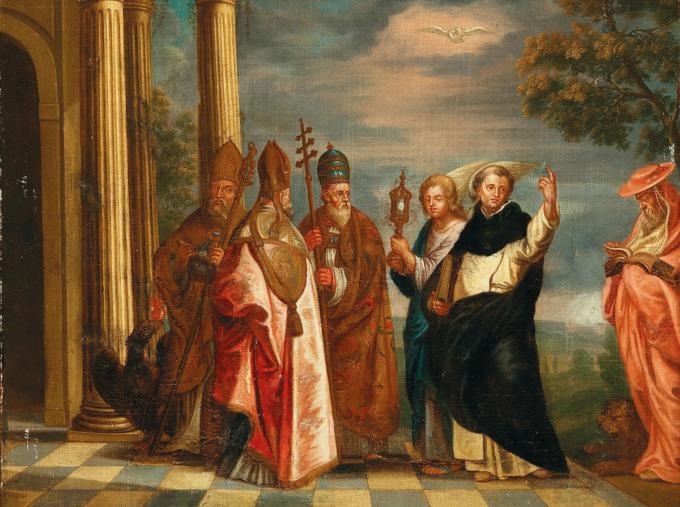
Faith
Thomas Aquinas is simply a giant -- of philosophy, theology, poetry, learning and teaching, counseling and advising -- and, if you asked him, of sinning!
When I first saw the title, I thought, "Huh? Praying with saints makes sense. With sinners, not so much." Then I caught myself. What about Augustine (who, of course, was both) or, for that matter, so was Peter?
Irish Dominican Friar Paul B. Murray is the author of the fourth "Notes on Prayer."
Presenting four saints, two men, two women, all four doctors of the church, he introduces us to them and relates their personal struggles with prayer and their own sins. St. Augustine is an obvious choice, but the other three are his fellow Dominican, Thomas Aquinas, and two Carmelite women, Teresa of Jesus (or Avila) and St. Therese of Lisieux.
Father Murray frames his notes with a quote from English Dominican Friar Vincent McNabb, who drew a marvelous contrast between the infamous Pharisee and the famous publican of Luke's Gospel (cf. 18-13-14). Father McNabb theorizes the sinful publican's doubt about his ability to pray or God's willingness to hear.
"The publican did not know that he was justified. If you had asked him, 'Can you pray?' he would likely have said, 'No, I cannot pray. I was thinking of asking the Pharisee. He seems to know all about it. I could only say I was a sinner. My past is so dreadful. I cannot imagine myself praying. I am better at stealing.'"
This frames the introduction to his four chosen saints. When you finish his meditations, you come to see that each of the four saints could easily have made the publican's words his or her own. And this is great news for us.
Augustine is the most easily recognized sinner and saint. His "Confessions," considered by many one of the classics of Western literature, is replete with his quite public confession of his sins and his ongoing struggle following his conversion.
Augustine tells us that his initial conversion was not easy. Arriving at his conversion, he thought he "had it made," only to find out that conversion is ongoing. Pope Benedict XVI, both a scholar of and a devotee of Augustine, said this of him, "St. Augustine, at the moment of his conversion, thought he had reached the heights of life with God ... He then discovered that the journey after conversion is a journey of conversion."
So, being converted is not just an event; it is an ongoing process.
Teresa of Jesus left us volumes of her spiritual writings and her contemporaries relate encountering her in her travels across Spain calling her Carmelite nuns to conversion. Often, she inspired more laity than nuns, and her call to conversion or renewal was not sugar-coated.
She readily expressed frustration, and rather than attributing the tepid response to her hearers, she wonders if it is her own sins that are the cause. But she keeps praying. She tells us that her praying was not easy, but she kept going.
Thomas Aquinas is simply a giant -- of philosophy, theology, poetry, learning and teaching, counseling and advising -- and, if you asked him, of sinning! He must have known he was brilliant, but we rarely see him using first person singular!
One of his secretaries collected Thomas's prayers. They are less known than his philosophy and theology. Here, he is less reticent about using that first person singular. In his "Prayer for the Remission of Sins," he starts off: "To you, O God, Fountain of Mercy, I come as a sinner." He goes on in the following phrases to refer to himself as blind, wounded, destitute, guilty, wretched and hard of heart, and for each, he asks a remedy from God: sight, cure, and so on.
Because he was aware of his shortcomings but more so of the mercy of God, he was able to give himself completely to what he advised us is the vocation of a Dominican -- "Sicut enim maius est illuminare quam lucere solum, ita maius est contemplata aliis tradere quam solum contemplari." ("Just as it is better to illuminate than merely to shine, so also it is better to deliver to others contemplated truths than merely to contemplate.")
The last of Father Murray's saints is the one closest to us in history, St. Therese of Lisieux -- "the Little Flower." Immensely popular, she is a model of simplicity and humility, but as with these other doctors, she also recognized her sinfulness and her need for God's mercy.
Precisely because she knew herself, she was able even more to rely on God to give her the confidence and grace never to fear seeking him and asking his mercy.
These four saints advise us: admit you are a sinner, seek the forgiveness and mercy of the Lord, and pray even if you think you are not the one who should be praying. God is listening.
Recent articles in the Faith & Family section
-
Freedom of worship for migrantsBishop Kevin C. Rhoades
-
Praying with saints and sinnersFather Robert M. O'Grady
-
'E pluribus unum'Archbishop Richard G. Henning
-
Making Faithful WitnessesMaureen Crowley Heil
-
Into the deepScott Hahn























